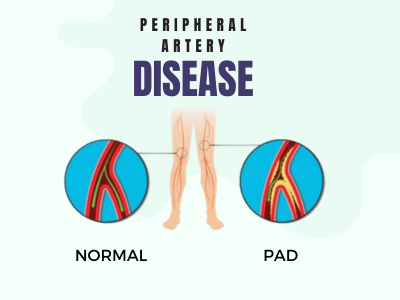Lifestyle modifications play a crucial role in managing Peripheral Arterial Disease (PAD) and reducing the risk of complications. Here are some
important lifestyle changes that can help improve vascular health:
1. Quit Smoking:
If you're a smoker, the most important step you should take is to quit smoking. Smoking damages the blood vessels, accelerates the progression of
PAD, and increases the risk of complications. Seek professional help, join smoking cessation programs, and utilize support systems to quit smoking
successfully.
2. Adopt a Healthy Diet:
A balanced and nutritious diet is essential for managing PAD. Focus on incorporating the following elements into your diet:
Fruits and Vegetables: Aim for a variety of colorful fruits and vegetables that are rich in antioxidants, vitamins, and minerals.
Whole Grains: Choose whole grains such as whole wheat, oats, quinoa, and brown rice, which provide fiber and essential nutrients.
Lean Proteins: Opt for lean sources of protein like fish, poultry, legumes, and tofu, while limiting red meat consumption.
Healthy Fats: Include sources of healthy fats like avocados, nuts, seeds, and olive oil while minimizing saturated and trans fats found in fried foods,
processed snacks, and high-fat dairy products.
3. Regular Physical Activity:
Engaging in regular exercise is vital for managing PAD. Talk to your healthcare professional before starting any exercise program, particularly if
you have advanced PAD. Gradually increase the duration and intensity of exercise to minimize discomfort. Recommended exercises for PAD include walking,
cycling, swimming, and low-impact aerobic exercises. Regular exercise improves blood flow, enhances circulation, and helps alleviate symptoms.
4. Weight Management:
Maintaining a healthy weight is important for managing PAD. If you're overweight or obese, losing weight can significantly improve symptoms and
reduce the strain on your cardiovascular system. Aim for gradual, sustainable weight loss through a combination of healthy eating and regular physical
activity.
5. Manage Blood Pressure and Cholesterol Levels:
Monitor your blood pressure regularly and work with your healthcare professional to keep it within a healthy range. High blood pressure puts added
stress on the blood vessels, worsening PAD symptoms. Similarly, manage your cholesterol levels, particularly LDL (bad) cholesterol, through a
combination of diet, exercise, and, if necessary, medications prescribed by your doctor.
6. Diabetes Management:
If you have diabetes, it's crucial to carefully manage your blood sugar levels. Uncontrolled diabetes can worsen PAD symptoms and increase the risk of
complications. Follow your healthcare professional's recommendations for monitoring blood sugar, taking medications, and adopting a diabetes-friendly
lifestyle.
7. Foot Care:
Proper foot care is essential for individuals with PAD. Check your feet regularly for any cuts, sores, or infections. Keep your feet clean, dry,
and moisturized. Wear comfortable, well-fitting shoes that provide proper support and avoid high heels or tight footwear that can restrict blood flow.
8. Stress Management:
Chronic stress can contribute to the progression of PAD and overall cardiovascular health. Incorporate stress management techniques into your daily
routine, such as deep breathing exercises, meditation, yoga, or engaging in hobbies and activities that help you relax and unwind.
9. Education and Awareness:
Increasing awareness about PAD, its risk factors, and preventive measures is crucial. Educate yourself and others about the importance of a healthy
lifestyle, risk factor management, and seeking medical attention for symptoms such as leg pain, numbness, or wounds that don't heal. Encourage family
members and friends to adopt healthy habits and undergo regular screenings, particularly if they have risk factors for PAD.
Remember, lifestyle modifications should be personalized to your specific needs and discussed with your healthcare professional. They are most
effective when combined with regular medical check-ups, adherence to prescribed medications, and ongoing support from healthcare providers. Making
these lifestyle changes can significantly improve your vascular health, manage PAD symptoms, and reduce the risk of complications.
